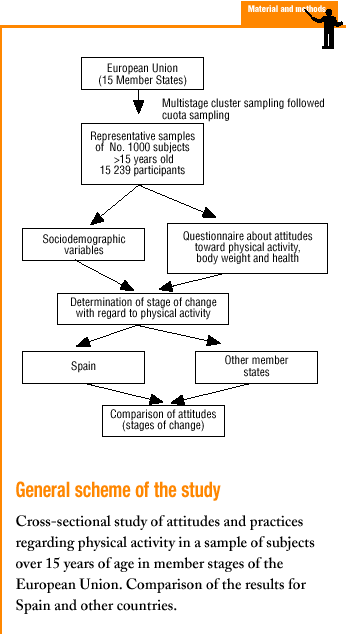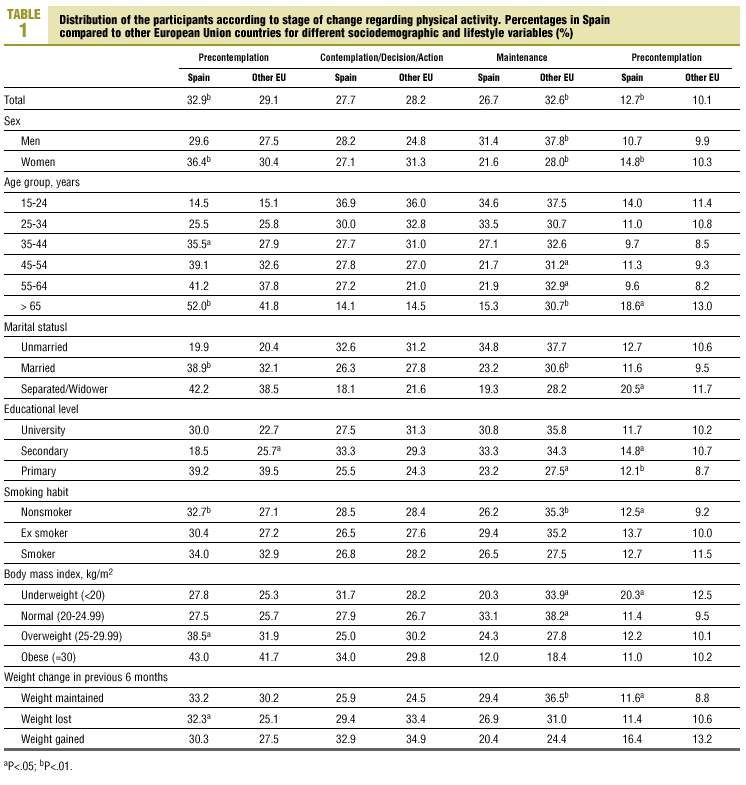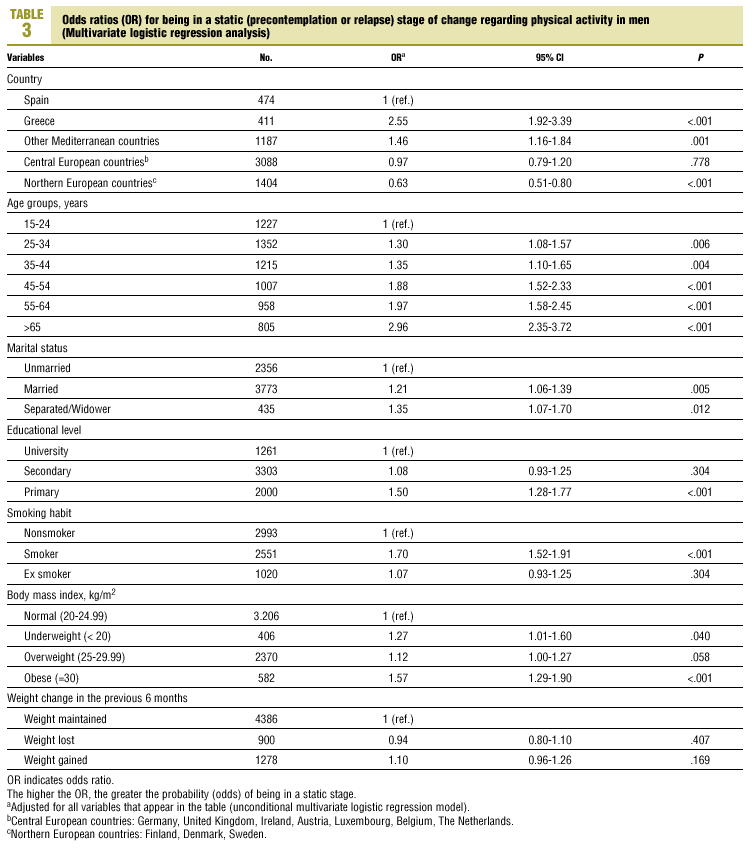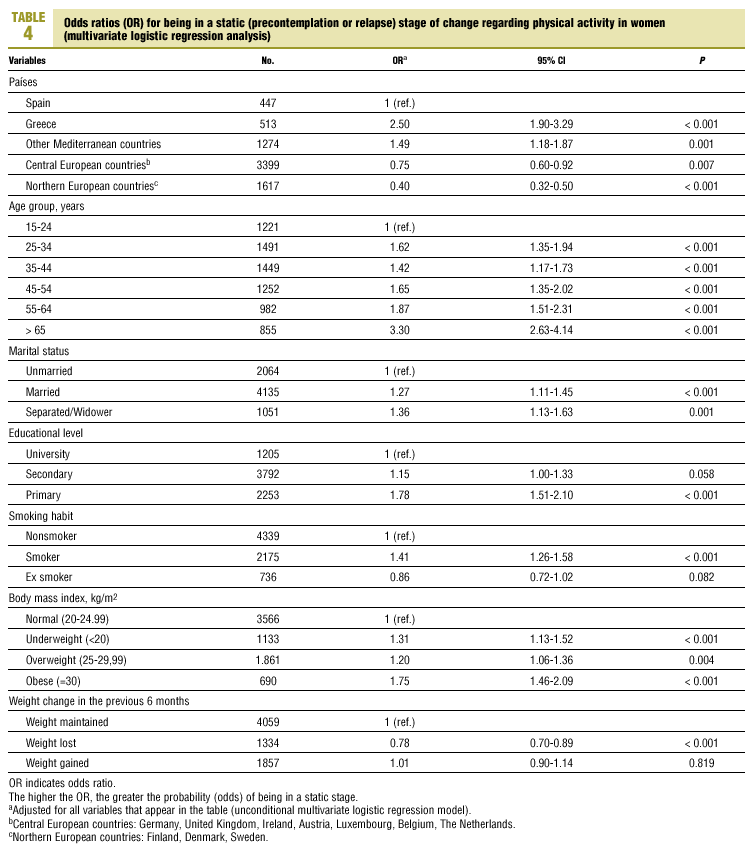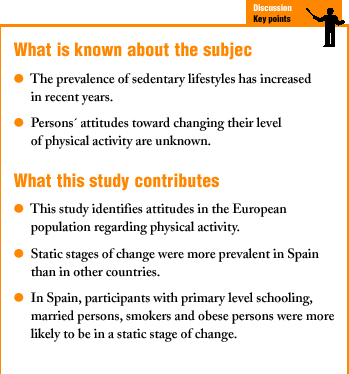Se llevó a cabo un análisis multivariante de regresión logística no condicional, para determinar las variables sociodemográficas relacionadas con encontrarse en un estado estático. Resultados. Los estados de cambio estáticos fueron más prevalentes en España que en el resto de la UE. En ambos sexos, los participantes españoles con estudios primarios, casados, fumadores y obesos presentaron mayor probabilidad de hallarse en un estado estático respecto a la actividad física. Conclusiones. La proporción de españoles que presenta una mala actitud de cambio hacia la actividad física es superior a la del resto de la UE, y son además menos perseverantes en los cambios positivos.
Introduction
Lifestyle is one of the main determinants of health, and has considerable impact on morbidity and mortality at the population level.1,2 In fact, a sedentary lifestyle and smoking are the principal causes of preventable death.3
The absence of physical activity has been related with overall mortality rates,1,2,4-6 and is an important predictor of both life expectancy and quality of life.3,7-10 Its etiological role in the appearance and maintenance of chronic diseases such as diabetes, hypertension, obesity, coronary disease and osteoporosis is well known,4,5,9,11-14 and it is considered a risk factor for certain types of cancer, e.g., of the breast,15,16 prostate17 and colon.18 A United States Surgeon General´s report on physical activity recommends at least 30 minutes of moderate-intensity physical activity on most, preferably all, days of the week.6,9
The need to educate the population about the health benefits to be obtained by increasing physical activity seems clear. However, this is a difficult task, as the recent increase in the prevalence of sedentary lifestyles had lead to the appearance of many potential target groups for interventions aimed at promoting physical activity.19
The approach used most frequently to fathom attitudes toward health-related behavioral changes is the transtheoretical model developed by Prochaska and others.20-22 According to this theory, healthy behaviors can be classified into six stages or phases of readiness for change. Given the high prevalence of sedentary lifestyles in Spain and Europe,23 new population-level strategies are urgently needed to identify the most highly exposed population groups. First, however, we should identify the most prevalent beliefs and attitudes in the population.
The aim of this study was to identify attitudes and practices in the Spanish population regarding physical activity, and to compare the situation in Spain with that in the rest of the member stages of the European Union (EU).
Material and methods
This study arose from our participation in a multicenter project involving a survey of Europeans older than 15 years living in 15 member stages. The survey investigated attitudes and beliefs regarding physical activity, body weight and health, with methods that have been described in detail previously.23-25 The survey was overseen by the Institute of European Food Studies.
The sample for each participating country consisted of approximately 1000 individuals older than 15 years, who were asked to be interviewed; in all 15 239 subjects participated. Subjects were chosen by a multistage procedure with quotas to ensure representativeness on the national and European level, in accordance with sociodemographic factors based on the most recent census statistics available.
The questionnaire consisted of several closed items to determine patterns of physical activity and sedentary behavior, attitudes and beliefs toward body weight and physical activity, and other sociodemographic characteristics. Each participant was asked about his or her degree of participation (hours per week) in different physical activities, and about sedentary activities (number of hours per week spent sitting). We used the Compendium of Physical Activities and the Paffenbarger questionnaire26,27 to assign levels of intensity of leisure time physical activity, and used the metabolic equivalents (METs) assigned to each activity to obtain weighted estimates of the total amount of physical activity.
Participants were classified into six possible stages of change by inquiring about their attitudes toward their own degree of leisure time physical activity22: precontemplation («I am not very active physically, I have no intention of being more active in the coming months»); contemplation («I am not very active physically, but I intend to increase my activity during the coming month»); decision («I am not very active physically, but I intend to increase my activity during the next month»); action («I have been quite active physically, but only since less than six months ago»); maintenance («I have been quite active physically since more than six months ago») and relapse («I used to be active physically a year ago, but I´ve been less active in recent months»).
The stages of change were subsequently regrouped into two categories: static (precontemplation and relapse) and dynamic stages (contemplation, decision, action and maintenance).
Chi-squared tests were used to compare the stage of change with regard to physical activity in Spain and the rest of the EU. Multivariate analysis with unconditional logistic regression was used to determine, for men and women separately, which variables were independently related with each stage of change.
Results
Table 1 shows the distribution of different sociodemographic and lifestyle variables in groups with different stages of change regarding physical activity in Spain and other EU countries. In Spain, 26.7% of the participants were in the maintenance stage, whereas this percentage was significantly higher (32.6%; P<.01) in the rest of the EU. The precontemplation stage was more prevalent in Spain (32.9%) than in the rest of the EU (29.1%).
The percentage of participants in the relapse stage was higher in Spain (12.7%) than in the rest of the EU (10.1%). This stage was also more prevalent in Spanish women (14.8%) than in women living in other EU countries (10.3%; P<.01).
The precontemplation stage was more prevalent among subjects older than 65 years and aged 35 to 44 years in Spain (52%) than in the rest of the EU (41.8%; P<.01). Prevalence of the maintenance stage in these age groups was 15.3% in Spain and 30.7% in the rest of the EU (P<.01). Among married persons the precontemplation stage was more prevalent in Spain (38.9%) than in the rest of the EU (32.1%; P<.01).
When we analyzed the findings across groups of countries, we found that the precontemplation stage was most prevalent in the «other Mediterranean countries» group (Portugal, France, Italy and Greece), followed by Spain. The relapse stage was most prevalent in Spain and in other Mediterranean countries (Table 2). The contemplation, decision and action stages were more prevalent in Northern Europe than in Mediterranean countries including Spain (Table 2).
Tables 3 and 4 show the results of the multivariate analysis, expressed as odd ratios (OR)28 for being in a static stage (precontemplation or relapse) regarding physical activity.
Greece had the highest prevalence of stages resistant to change, and we therefore decided to analyze this country separately. In Greek men the OR for static stage was 2.55 (95% CI, 1.92-3.39) in comparison to Spanish men. Men older than 45 years were more likely to be in a static stage than men aged 15 to 24 years (OR, 1.88 for men aged 45-54 years, OR, 1.97 for men aged 55-64 years, and OR, 2.96 for men aged 65 years and older).
Men with primary school education, who were married, who smoked, or who were overweight or obese, were more likely to be in the static stage group rather than the active stage group.
The findings for women were similar. Women in Greece and other Mediterranean countries were more likely than Spanish women to be in a static stage for physical activity, whereas static stages were less prevalent in women living in northern and central Europe.
Interestingly, in persons older than 25 years we noted an inverse relationship with age, and an increase in the prevalence of static stages. This association remained approximately constant and did not increase further until past the age of 65 years.
Being unmarried and having a normal body mass index (20-25 kg/m2) was associated with a lower probability of being in a static stage of change rather than an active stage. The likelihood of being in a static stage regarding change in attitude toward physical activity was greater in women with a primary school education and among smokers in comparison to women with university-level education and nonsmokers.
Discussion
This study set out to identify attitudes and practices regarding physical activity, and to compare the findings for Spain with other EU countries. To our knowledge this is the first study that provides a global analysis of attitudes toward change regarding physical activity in a representative sample of the Spanish population, and that compare the findings in Spain with the situation in the rest of the EU. Our analysis is part of a pan-European project with a common design and uniform methods for all participating countries, features that allow comparisons to be drawn between countries. We determined attitudes in the population toward changes in the level of physical activity, and classified participants according to their stage of change. The validity of this classification has been widely recognized in previous studies.20,30,32 This has made it possible to identify the population groups most highly exposed to sedentary lifestyles, so that interventions can be developed specifically for these groups. Analysis of the stages of change regarding physical activity in the general population has thus far taken a back seat in research on physical activity, with the result that we currently know which behaviors ought to be changed, but know less about the means needed to change them.32
Our data show worrying proportions of Spanish participants with the poorest attitude toward physical activity (precontemplation stage). The figures are higher than in other countries in our setting, with significant differences appearing for women, persons aged 35 to 44 years, and those older than 65 years, married persons, nonsmokers, persons who are overweight, and those who had lost weight in the previous six months. These results regarding attitudes toward physical activity are consistent with the data for the actual prevalence of physical activity (i.e., practices) we obtained in a pan-European study.23 Not only is there a high percentage of Spaniards with a sedentary lifestyle, but in addition, they show little inclination to change.
Higher levels of education are associated, in general, with healthier behaviors which tend to be imitated after a time by persons with lower levels of education.33 The present study also found this to be the case.
Generally speaking, the number of individuals in the maintenance stage was higher in the EU than in Spain. In other words, once they decide to increase their physical activity, other Europeans tend to be more perseverant than Spaniards. It was also worrying to find that the relapse stage was more prevalent in Spain than in the rest of the EU, with an especially large difference for women.
This study also confirms the well-known association between smoking and a sedentary lifestyle.3,4,18 Interestingly, we identified this association in relation not only with practices,23 but also with attitudes, which may well account for the coexistence of different unhealthy lifestyles in different population groups.
There may have been classification bias owing to translation of the questionnaire into different languages, but this is unlikely given the considerable effort devoted to back-translation of the instrument as a quality check, and given that a small pilot study was done in each participating country to ensure that the original meaning of each item had been preserved. The possibility of selection bias as a result of selective participation was negligible given that response rates were better than 80% in all countries, and that the study was designed with particular attention toward ensuring representativeness of the sample in each country and for the EU in general. Although residual confounders cannot be ruled out completely, the main confounders were controlled for in the multivariate analysis, as shown in Tables 3 and 4.
The results of this study pose a challenge to all health professionals as well as to others responsible for health promotion, inasmuch as they show that the Spanish population is one of the worst in the EU with regard to attitudes toward changes in the level of physical activity.
Correspondence: Miguel Ángel Martínez-González. Unidad de Epidemiología y Salud Pública. Facultad de Medicina. Universidad de Navarra. Irunlarrea, s/n. 31008 Pamplona. España. E-mail: mamartinez@unav.es
This project was financed by the Institute of European Food Studies (IEFS) and the European Union (DG-V), Project number 96 201705 05F03 (96CVVF3-429-0).
Manuscript received 17 July 2002.
Manuscript accepted for publication 14 October 2002.







